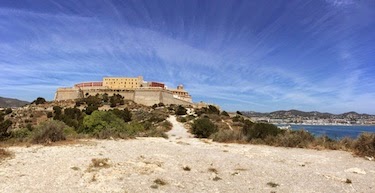For the most part, the two and half millennia of the populated history of Ibiza could be described as peaceful, bucolic, and agrarian. That is except for four months or so of the most chilling bloodiness the 20th century can muster up, which is saying a lot.
For a couple of dozen or more centuries, Ibicencos have enjoyed the peacefulness that being a bit out of the way can bring about. The earliest known inhabitants of the island were Phoenicians, who named the island “Ibossim”, from iboshim, a dedication to the Egyptian god Bes. The Romans romanized the Phoenician name to Ebusus, and the Greeks applied the name Pitiuses (you’ll recall that it means “Pine Islands”).
For a couple of centuries, Ibiza was an important stop on Western Mediterranean trade routes. The first inkling of any conflict came to the island during the Second Punic War in the early 200’s BC (this is the war in which Hannibal marched his elephants from Spain, through the Alps, and attacked Italy from the north). While elephant-empowered war machines trooped around the continent to the north, Ibiza was loyal to Carthage: as the Carthaginian military lost its positions on mainland Spain, they fled across the Mediterranean, supplying themselves at Ibiza as they went. Ibiza subsequently negotiated a favorable treaty with Rome, which resulted in the island settling into peacefulness for another millennia or so.
 |
| The Walled Medieval Fortress of Ibiza Town |
 |
| Ancient Roman Necropolis at Ibiza |
I should point out at this point that archaeological remnants of the Phoenician-Carthiginian-Roman era still exist on the island. Just a hundred yards or so from where we’re staying is the island’s archaeology museum. Only a few decades ago, as the story goes, a farmer accidentally discovered the ancient Roman necropolis. Personally, we imagine quite a few people knew it was there for quite a few years, but nevertheless, the site is an ongoing excavation with a museum that we will be visiting before we leave.
As the moors swept up from Africa and into Spain, so too they took over Ibiza. The small population either converted to Islam or fled and the island was administered by the Muslim kingdom of Dénia on the nearby mainland. During the crusades, Ibiza was “liberated” by Sigurd I, King of Norway, the muslims deported, and in 1235 it was conquered by the Spanish Aragon King James I, which is to say he came and claimed Ibiza as his own. The island has been Spanish ever since.
Which brings us to the 20th century, where the history of this tiny little island gets hard to read.
Until 1936, Ibicencos peacefully farmed olives and almonds and made wool from their sheep. They were a conservative and religious people, nearly the entire population practicing Roman Catholicism. Americans learn very little about the Spanish Civil War. What we’re taught is that it was a war between the democratic republicans and the fascist nationalists, that it was a dress rehearsal for Hitler and Mussolini in their support of General Francisco Franco, and that Franco won, leading to a fascist dictatorship that would last until 1975.
We assume that the losing republican democrats were the “good guys”, but in Ibiza they were a perfect example of the adage “the enemy of your enemy is not necessarily your friend”. It’s true the nascent Spanish republic instituted the sort of reforms we would expect to come of a true democracy: from basic economic reforms and transforming Spain’s previously archaic agricultural system to basic separation of church and state. But what the republic represented in Ibiza at the outbreak of hostilities was far less admirable.
Ibiza suffered the misfortune of being in proximity to Majorca, where one of General Franco’s two co-conspirators, a General Goded, had seized the city of Palma de Majorca. It was an obvious early target of the republican military, and Ibiza was the logical launching point of an attack on Majorca.
It was the outbreak of the war, and fervent republican forces quickly overtook the nearby island of Formentera. From there, the republicans demanded the surrender of Ibiza, but the governor, a principled traditionalist, stood firm. Enraged and vengeful republican forces poured ashore at the town of Santa Eularia.
It’s understandable that Ibiza, a peaceful agricultural community that was devoutly Catholic, would be nationalist. The monarchy, far removed on the Spanish mainland, had served them (stayed out of their affairs for the most part) well. Nationalists, especially monarchists, were similarly devout throughout Spain. Hence, the church was unfortunately aligned with the nationalists.
Bloodthirsty, republican forces sweeping into Ibiza burned every church on the island and summarily executed every priest and supporter of nationalism they could lay hands on. Stories are told of priests whose survival was only brought about by their being hidden by local Ibicencos. If martyrdom is basis for sainthood, Ibiza likely has the highest concentration of native saints second only to Rome.
No match for the republican forces, the island quickly fell to republican control. The atrocities continued as the so-called “democratically elected government’s” forces attempted to purge the island of nationalist sympathizers. A few months later, when the tide turned against the republic and the island fell back to the nationalists, things fared no better, as fascists in turn attempted to purge the island of republican sympathizers. People were roused from bed for having been known to aid the republicans (no doubt in most cases only to survive, not because of political principles)–or worse, relatives of such people were roused only because they were related–and they were taken to the cemetery, lined up against the wall, and shot.
The bloodthirst of 1936 eventually settled down, but fascist dictatorial rule would continue for an incredible 40 more years. Today, it’s hard to imagine what happened on this peaceful little island, so out of the way a place, and it’s hard to imagine that we (Americans) hardly hear such close-to-heart details. The Spanish Civil War, after all, was in our textbooks as a lost battle between the forces of democracy and the forces of fascism.
We learned of all this, ironically, by visiting the church that might have been the church where my great-great-grandfather was baptized. I had asked the attendant whether it was possible to inspect the baptismal records from around 1820. He had a sad look on his face, even though he was obviously born well after the war, and informed me that no baptismal records prior to 1936 were available anywhere on the island, that they had been burned in the war. He shook his head and said, “The republic,” pronounced as the Spanish do, “re-POOB-lick”.
That was when I realized history isn’t always what it seems, especially looking at the walls of that cemetery as I searched for potential ancestors buried there.
For an excellent and superbly written history of this wonderful little island’s role in the Spanish Civil War, click here to read American Emily Kaufman’s history series on LiveIbiza.com. Emily is an American expat living in, and loving, Ibiza.






